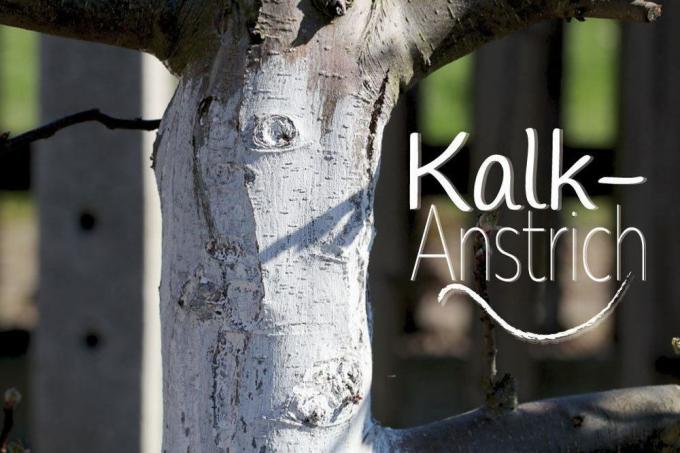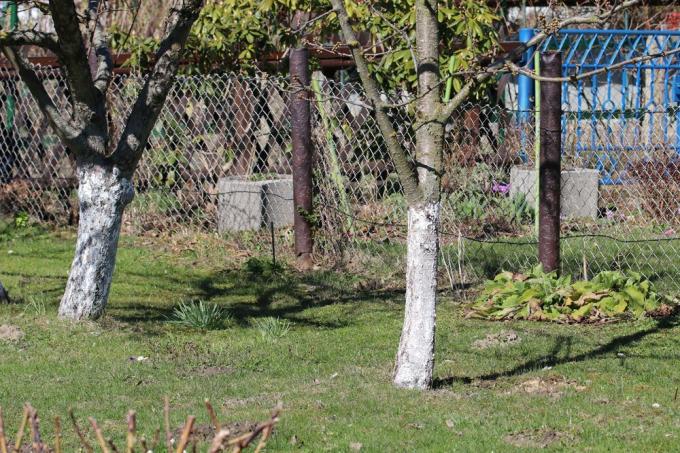
table of contents
- Lime paint
- effect
- Frost protection
- Attach
- time
- Before the lime painting
- Basic recipe
- Lime paint additions
- The painting
Have you ever noticed that young trees are often painted white in winter? In case you've wondered why, here's the answer.
Lime paint
Lime paint against frost damage and more
The so-called lime coating serves primarily to protect young trees from weather damage. Frost and cold make the bark to create, it bursts open and becomes a gateway for damage. However, game browsing is also a problem that trees have to struggle with again and again. Lime paint can also have a preventive effect here.
effect
What does the lime paint really work against?
The natural product lime is available in many colors, it is used here as a pigment. Since the bright white paint can reflect the sun's rays, lime paint is particularly suitable on fruit trees.
Lime paint works against many problems, especially in fruit trees:
- Protection against frost damage
- Protection against game browsing
- Protection against disease

Frost protection
Apply lime paint as frost protection
Although the sun can shine in winter, the temperatures are icy and trees freeze. The result is cracks in the fruit tree bark. This happens because the tree is usually only exposed to the sun from one side. On this side, the heat expands the bark, while on the other side it stiffens. Since young trees still have very thin bark, this uneven distribution of heat creates cracks that are a gateway for pathogens.
How does lime paint work against the cold?
If you put lime on the trunk of your young fruit tree, the sun will be reflected strongly and the heat will not be able to spread. This means that the bark does not expand and there are no cracks. As a result, your tree is better protected from invading pathogens.
In addition, the lime paint slows down growth in winter. Flower buds do not sprout as quickly and are not exposed to the risk of late frost.
Attach
Application of lime against game bites
Game is almost continuously foraging in winter. It is granted to him, but the young bark of your fruit tree does not have to be straight. However, this is with deer and co. very popular because it is tasty and easy to bite. By adding lime, the taste of the young rind becomes bitter and the game is less likely to use it.
What happens when game is bitten?
If game feeds on the bark of a young tree, there is a risk that the tree will die. This happens because the vessels for nutrients and water are located in the bark. Bite damage can mean that nutrients can no longer be transported into the leaves and branches and the tree withers.
time
When is the right time to paint with lime?
In theory, you can apply the paint all year round. The right time has come immediately after a tree has been planted. It is important that you apply the paint before the first frost, if possible, so that you can get through the first winter without any problems. A dry day with lots of sun is best so that the paint is not immediately washed off by the rain. If the old paintwork has faded, you can always pick up a brush and apply new lime paint.

Before the lime painting
Carry out the lime coating optimally
Before you apply the lime, there are a few important factors you should consider. A young tree can usually be treated immediately because its bark is still smooth and absorbs the color well. An older tree, on the other hand, has a rough bark that contains fracture marks in many places. Here you first need to remove the loose bark with a spatula.
Tip: You do not have to remove lichen, as the lime paint will displace it anyway.
The most important tips in brief:
- Recycle older trees and remove loose pieces of bark
- You can paint it all year round
- The best protection is achieved when applied before the first frost
- choose a dry, sunny day for treatment
- pale lime coats can be repeated over and over again
The ingredients for making the paint
If you want to add lime to protect your trees, you can easily make the paint you need yourself. Products from the hardware store are often more expensive than buying the ingredients you need.
Basic recipe
The basic recipe for lime paint
- ten liters of water
- 1.5 kilograms of quicklime
- 500 grams of wallpaper paste

Creating the color
Before starting the mixture, you should protect yourself with gloves and safety glasses. Lime steams, is warm and has a caustic effect. You need a large bucket, rinsed paint buckets are well suited! First the lime powder is put into the bucket, then the water is poured in by the liter.
Important: Be careful not to distribute any splashes, as lime is corrosive. You should also not inhale the vapors produced. If available, you can wear a protective mask.
You only add the wallpaper paste freshly when you want to apply the paint.
Lime paint additions
Make additives for lime paint
If you want to make your trees particularly happy, you can add nutrients to your self-made lime paint. This means that the tree is even better protected from pests.
Suitable additions are:
- Cow dung
- Horsetail broth
- Horn meal
- Tansy broth

The painting
To get started, all you need is the paint and a thick tassel. Both the trunk and the main branches will be painted.
- start painting just above the ground and work your way up to the thick branches
- save young shoots and fresh buds
You may have to repeat the painting a few times. Please note that there must be a waiting time of at least 24 hours between two coats.

